Welcome to the
Run on Sun Monthly Newsletter

In this Issue: |
September, 2016
Volume: 7 Issue: 9
Solving the Solar Sustainability ProblemEditor's Note: This is the third of a three-part series asking the question: Is Solar Unsustainable? You can find Part One: Shoddy Work here, and Part Two: Shady Business Practices here. It is easy enough to cast aspersions, but it is far more valuable to offer suggestions for improvement. Having devoted 3,000 words to the former, it is time offer some thoughts on the latter. Too Big to FulfillI attended a solar workshop sponsored by our favorite distributor, BayWa r.e., and I heard the head of a solar company offer what might have been the saddest assessment of success I had ever heard.
When a company becomes too big to fulfill its obligation to provide top-quality work, it is too big. A greater emphasis on training is one way to grow while still keeping the quality high. NABCEP is a good step in that direction, but companies need to support their employees to get the training that they need. (Of course, this says nothing about companies that are looking to rip people off - they represent an entirely different type of problem. More about dealing with them later.) From Customers to ClientsRight now the solar industry treats consumers like customers, and that's a problem. Customers represent a transactional relationship - gas stations and fast food restaurants have customers. The customer hands over their money and gets a commodity in return - end of story. But purchasers of solar power systems are entering into a long-term relationship with the product that we are selling - quite likely the longest lived product they will ever own, short of the house itself. A relationship can only last that long when it is founded in trust, and that is the nature of a client relationship. Recognizing that we are entering into a client relationship changes the focus from the short term transaction to the long-term process of building confidence. That means starting with absolute candor and at every step in the process enhancing the client's trust. The solar professional owes the client three duties: a duty of candor, a duty of communication, and a fiduciary duty. The consequence of those duties is that you have to keep your client in the loop, and you must safeguard your client's financial well-being. How do you fulfill those duties? By communicating clearly at every step in the process, identifying and disclosing problems as they arise, and by providing comprehensive contracts and then living by that contract (i.e., keeping change orders to a minimum). Time to Come CleanSolar companies need to provide comprehensive disclosures to their clients. At a minimum, such disclosures should include:
Such comprehensive disclosures would eliminate the scourge of "generic solar systems," and would allow consumers to make more accurate comparisons of competing bids. Guiding the Market's 'Invisible Hand'I spoke about many of these issues on a panel this week as SPI. There was a great deal of agreement among the panelists, despite our disparate backgrounds ranging from a (refreshingly progressive muni utility) to Sunrun to me. But the one comment that bothered me the most came from industry veteran and CALSEIA board member, Ed Murray. In response to my stated concern that the bad business practices documented in my first two posts in this series constituted a serious threat to the industry, Mr. Murray's response was that "the market will take care of it, bad companies will fail and the good ones will survive, hopefully without too much of a black eye to the industry." If only it were that easy. We rejected such laissez faire notions with the rise of the modern regulatory state decades ago, and to suggest that the solar industry can or should survive without additional regulatory involvement is misguided. The solar industry is far less regulated here in California than it is in many states. For example, to participate in the solar incentive program in New York solar installers must be NABCEP certified. Such a requirement here in the largest solar market in the country would go a long way toward cleaning up our act. CALSEIA has a consumer complaint process - consumers who feel they've been badly treated by a solar company in California can start the process by clicking here to fill out their complaint form - but the process itself is secret, and the rest of the consuming public never learns about those complaints. Similarly, utilities often have experience with bad solar contractors who do shoddy work, but they don't publicize what they have learned so the public remains uneducated about the bad actors out there. That should change. Unfortunately, that leaves us, for now, in a position where the burden remains on the potential client to do the homework needed to find a reliable contractor. NABCEP's member list is a good resource (although made less so since you can no longer sort results by zip code), as is CALSEIA's. State contractor's boards - responsible for licensing contractors - are a good source to verify that the contractor is properly licensed, and to determine whether there are any outstanding complaints against them. (For California, here is a link to the "Check a License" page at the state contractors board.) Yelp, Angie's List, and the BBB can all be helpful. But consumers must demand to be treated like the clients that they are, and reject solar companies that fail to honor that demand. |
“To suggest that the solar industry can or should survive without additional regulatory involvement is misguided…”
Get your copy of
Commercial Solar:
Step-by-Step
from
Run on Sun
Founder & CEO
Jim Jenal

Now available on Amazon.com
in both
Print & Kindle versions.
Bonus - Buy the Print version…
Get the
Kindle version for Free!
Commercial Solar:
Step-by-Step
from Run on Sun
Founder & CEO
Jim Jenal

Now available on Amazon.com
in both Print & Kindle versions.
Get the Kindle version for Free!
Help Us Spread the News!


We use Angie's List to assess whether we're doing a good job keeping valued clients happy. Please visit AngiesList.com in order to grade our quality of work and client service.
Solar Power International 2016: Industry Latest and GreatestEvery September we pack our bags and head to the largest solar conference and exposition in the country; Solar Power International. This is when we get to connect with the broader solar community, advocates, and friends working far and wide for the betterment of the world through distributed clean energy. It is also the time when manufacturers unveil their latest technologies. These technology improvements come fast and furious in an attempt to stay ahead of the curve in a competitive industry. Just two years ago when I started working with Run on Sun we were able to get 270 watt panels from LG. What is coming from them in the next year will blow your mind. Here is my run down of the top take-aways from SPI 2016… Panel: "Survival of the Fittest, the Future of Residential Solar"Some of you may have seen the three part series Run on Sun's CEO, Jim Jenal, wrote recently about what we need to do to be sustainable as an industry facing a crisis of increasingly shoddy workmanship and shady business practices. As part of the convention's educational program, Jim was invited to participate on a panel of solar professionals to discuss the future of residential solar. The panel consisted of a wide range of backgrounds including a representative from a national company, Sunrun's Michael Grasso, Rick Luna from a municipal utility CPS Energy, Ed Murray from a medium sized company, Aztec Solar, as well as national advocacy group SEIA, and Jim representing the small installer at Run on Sun. The panelists discussed their take on who will dominate the residential solar space and what will the predominant business model be in five years. This was a perfect platform to raise the very real issues of quality facing the industry and Jim did not disappoint! Of course Sunrun's Grasso asserted that national scale companies continuing the leasing model with storage will dominate in the future. But there were many nods of agreement in the audience when Jim insisted that the current status quo is not sustainable. Giant publicly traded national companies operating in the red and pushing customers into bad deals are going to cause a backlash. We've already seen many law suits and bankruptcies in the industry. Solar City's Better Business Bureau rating in the Bay area is an embarrassing 80% negative. The notion that Ed Murray, from SEIA, put forth that the market will naturally take care of the bad companies is just not a sustainable way forward or an ethical one. As more and more consumers get hit with bad contracts and solar systems, the market will be left with a bad taste for solar. The people in this industry who are doing it for the right reasons, aiming to help people save money and reduce their impact on the ecosystem need to demand that there is more oversight over the quality of systems and some legal standards around contracts. Jim's comments seemed to be well received in the audience as most people attending were people who work in solar for the right reasons given they are investing in the hefty price-tag to attend the convention. But the disparate opinions on the panel itself was interesting to say the least. I don't know if the reps for big companies are just out of touch with what is happening on the ground or if they are in denial. Everyone agreed that a future will include storage or other bundled options for improving home efficiencies. However, Jim noted that storage needs to be presented to clients in a transparent way so they understand the true value of storage and whether it makes sense for them or not. If you are on a tiered rate system with no demand charges there likely is no value in storage. Solar stakeholders from advocates to installers need be fostering business practices that focus on transparent education for consumers instead of just closing every sell if we are to survive as an industry and continue to grow solar as the incredibly valuable resource that it is. LG Solar Panels Up the AnteWe have been installing exclusively LG panels since 2012. Why? We believe LG panels are the best for our clients for two main reasons. 1. As a diversified company we, and our clients, can rely upon them to stick around to back their 25 year warranty no matter what happens in the wider solar industry. And 2. LG has an incredible R&D department churning out ground-breaking improvements keeping them at the top in both quality and output year after year. Last year LG announced 320 watt panels would be coming and we were fortunate to be one of the first to install these at a beautiful home in Altadena last Spring.
There has been a limited market for bi-facial panels historically. Sometimes you see them on shade structures, but the price point is higher than standard panels. These new LG panels are in a commercial 72-cell format so they are aiming to capture commercial projects that can really bank that extra output capacity. Enphase Energy Total RethinkThe Enphase booth was seriously hoppin' throughout the expo! Unsurprisingly with a total redesign of their system from the microinverter to the cable and even a special junction box.
3. Smart Junction: Lastly they rolled out a junction box wired up for easy installation between the branch circuit of micros and the run to the electrical service. All of these improvements come together to create a system that includes the microinverters we know and trust at a lower cost with a simpler and quicker installation. Everest Solar Racking Shares at SPI
Edisun Dual Axis Tracker - PV Booster
A Solar Wedding
|
Run on Sun PSA: Time to Wash Your Array!Here in SoCal we are blessed with endless warm sunny days. The down side however is that it can be many months between invaluable air-purifying rain showers. For your solar array, this means there is nothing to wash away the accumulated dust and detritus from nearby trees. In summer months ash from nearby mountain fires adds to the mix. Consider this a Run on Sun PSA… IT'S TIME TO RINSE OFF YOUR PANELS!!! When discussing solar with new clients often the topic of cleaning comes up. This is because some solar companies use the concept of cleaning your array as a way to convince you you need a leased system with ongoing maintenance. However, we believe this is a bit of a scam. You don't need to pay someone to get up on your roof with a squeegie every week.
Check out this recent case study that brought this issue to our attention: A little while ago we heard from a client who did some great analysis using the Enphase monitoring on his system before and after he decided to clean his panels. He found there was an 8% improvement in the period after cleaning.
|


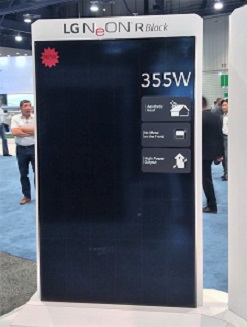
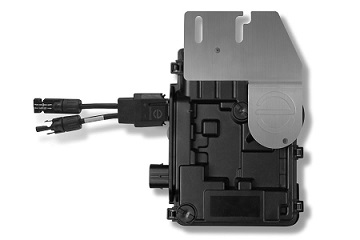
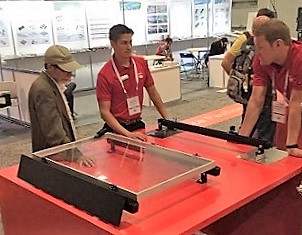
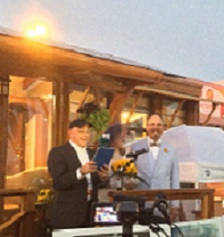
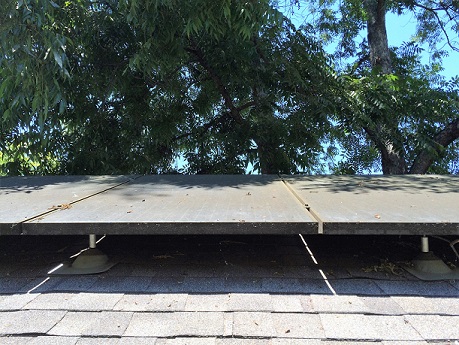
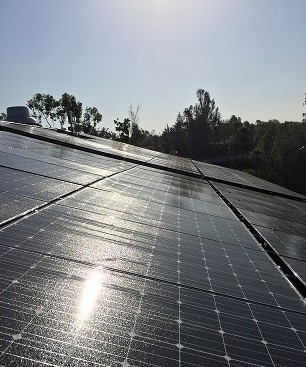 Shiny new panels at Chandler School
Shiny new panels at Chandler School